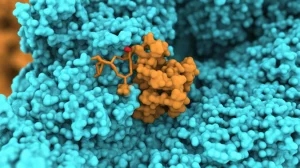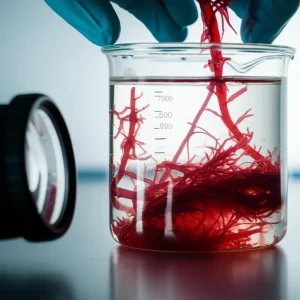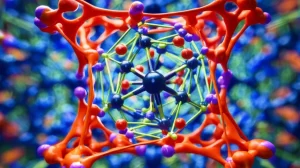Our New Molecular Champions: Tackling Tough Bugs and TB!
Hey everyone! Ever wonder how scientists come up with new medicines to fight those nasty bugs that just won’t quit? Well, let me tell you, it’s a bit like being a molecular detective and a master chef all rolled into one. We’ve been busy in the lab, cooking up some new compounds that we think have real promise against tuberculosis (TB) and other stubborn bacterial infections. It’s a big deal because, as you know, antibiotic resistance is a growing headache, and TB is still a major global health threat. So, we need new weapons in our arsenal, and that’s where our story begins!
Why These Molecules? The Magic of Heterocycles
We’re particularly fascinated by compounds built around what chemists call benzimidazole and thiazole structures. Think of them as special molecular LEGO bricks. These types of molecules have a great track record, showing off all sorts of cool biological powers – they can be antibacterial, antitubercular, antifungal, and even anticancer! Specifically, a scaffold called imidazo[2,1-b]thiazole has been a rising star in drug discovery.
Now, we thought, what if we added another well-known champion to this mix? Enter sulfonamides. You might have heard of sulfa drugs; they’re famous for their antimicrobial punch. So, our big idea was to fuse these promising bits together: a benzimidazo-thiazole core, jazzed up with aryl groups (that’s just a fancy term for certain ring structures) and a sulfonamide tail. We felt this combo, the 2-(aryl)benzo[d]imidazo[2,1-b]thiazole-7-sulfonamide family, hadn’t really been explored enough for its dual power against both general bacteria and the tough-to-kill TB bug, Mycobacterium tuberculosis.
Rolling Up Our Sleeves: The Synthesis Story
Alright, so how did we actually make these new molecules? It was a multi-step chemical recipe, a bit like a culinary challenge!
- First, we took a readily available chemical, 4-aminobenzenesulfonamide, and reacted it with ammonium thiocyanate in acidic water, heated up nice and hot (95–100 °C). This step helped form a key part of our molecule, giving us 4-thioureidobenzenesulfonamide.
- Next up, this intermediate got a treatment with bromine in chloroform. This was a bit of a slow cooker – stirred at room temperature for 12 hours, then heated to 50–55 °C for another 12 hours. This cyclization (ring-forming) reaction gave us 2-aminobenzo[d]thiazole-6-sulfonamide (let’s call it compound 3 for short). This was a crucial building block.
- For the grand finale, we took our compound 3 and reacted it with various substituted 2-bromoacetophenones. Think of these as different “flavors” or “decorations” we could add to our main structure. This reaction was done in PEG-400, which is a more environmentally friendly solvent – we like to keep it green where we can! This step, under reflux (boiling gently), gave us our final series of eight target compounds, which we’ve named 5a through 5h.
The yields (how much stuff we got) varied a bit, depending on what kind of “decoration” (substituent) we used on the acetophenone. Some make the reaction go smoother than others. And, of course, we had to be sure we actually made what we thought we made! So, we used a bunch of cool spectroscopic techniques like FT-IR, 1H NMR, and 13C NMR. These are like molecular fingerprinting tools that confirm the structure and purity of our new creations. The data looked good, confirming we had our desired 2-(aryl)benzo[d]imidazo[2,1-b]thiazole-7-sulfonamide derivatives.
![Macro lens, 60mm, high detail shot of colorful molecular models representing benzimidazo[2,1-b]thiazole-7-sulfonamide derivatives on a clean, white lab bench, precise focusing, controlled studio lighting to highlight structural details.](https://scienzachiara.it/wp-content/uploads/2025/05/268/146_macro-lens-60mm-high-detail-shot-of-colorful-molecular-models-representing-benzimidazo21-bthiazole-7-sulfonamide-derivatives-on-a-clean-white.webp)
Putting Them to the Test: How Did They Fight?
Making new molecules is fun, but the real question is: do they work? We put our new derivatives through their paces against the TB bug and a panel of other bacteria.
Battling the TB Bug (Antitubercular Activity)
For TB, we used the Mycobacterium tuberculosis H37Rv strain – a standard bad guy in TB research. We used a clever test called the Microplate Alamar Blue Assay (MABA). It’s neat because it changes color: blue means the bacteria are inhibited (yay!), and pink means they’re growing (boo!). The lowest concentration of our compound that keeps the well blue is called the Minimum Inhibitory Concentration, or MIC. The lower the MIC, the more potent the compound.
And guess what? Some of our new derivatives were real champs! Compounds 5b (with a bromo group), 5d (with a fluoro group), and 5h (with a methyl group) showed potent activity with an MIC of just 1.6 µg/mL. That’s on par with some standard TB drugs like isoniazid and ethambutol! This got us pretty excited. It seems that having those halogen (bromo, fluoro) or small methyl groups in a specific position (the para position on the aryl ring) really boosts their power. Compound 5f, with two chloro groups, was also pretty good, with an MIC of 3.125 µg/mL, matching another TB drug, pyrazinamide. Others, like 5a (with a methoxy group), weren’t quite as strong, suggesting that electron-donating groups might not be the best for this particular fight.
This tells us that the specific “decorations” we add really matter – a classic case of structure-activity relationship (SAR)!
Taking on Other Bacteria (Antibacterial Activity)
Next, we pitted our compounds against a range of common bacteria, both Gram-positive (like Staphylococcus aureus and Bacillus subtilis) and Gram-negative (like Escherichia coli and Klebsiella pneumoniae). Gram-negative bacteria are generally tougher nuts to crack because they have an extra outer membrane.
Here, one compound really stood out: 5f, our 2-(2,4-dichlorophenyl) derivative. It showed significant activity, especially against the Gram-positive bacteria, with MICs as low as 6.25 µg/mL for S. aureus and B. subtilis. We think those two chlorine atoms might help it get into the bacterial cells better or interact more strongly with its target. Against the Gram-negative bacteria, 5f was also the best of our bunch, though still not as potent as against the Gram-positives. Most of our other derivatives showed more moderate activity.
We used ciprofloxacin, a well-known broad-spectrum antibiotic, as our benchmark. While none of our current derivatives beat ciprofloxacin (it’s a tough act to follow!), 5f definitely showed it has potential, especially for Gram-positive infections. Again, the type and position of the substituents on the aryl ring played a big role.

Peeking Under the Hood: Computational Insights
Beyond just testing them in dishes, we wanted to understand why some compounds were better than others. This is where computers come in handy! We used techniques like molecular docking and Density Functional Theory (DFT) to get a closer look.
Molecular Docking: The Key in the Lock
Imagine a specific protein in the bacteria is like a lock, and our drug molecule is the key. If the key fits well, it can stop the lock (protein) from working, which is bad news for the bacteria. Molecular docking simulates this “fitting” process on a computer.
For TB, we looked at an enzyme called DprE1. It’s crucial for building the mycobacterial cell wall. Our potent anti-TB compounds 5b, 5d, and 5h showed good binding scores (−6.2 to −5.9 kcal/mol) with DprE1. They all seemed to make an important hydrogen bond with an amino acid called Lys134 in the enzyme’s active site. This suggests they might be working by gumming up this essential enzyme.
For general antibacterial activity, we focused on compound 5f and an enzyme target called 2,2-dialkylglycine decarboxylase (DGD), which is involved in bacterial amino acid metabolism. Compound 5f showed a fantastic docking score of −7.9 kcal/mol, even better than the standard ciprofloxacin (−6.83 kcal/mol) in this model! It formed interactions with several amino acids in the enzyme, including a hydrogen bond with Gly111.
DFT and MESP: Understanding Electronic Personalities
DFT calculations help us understand the electronic structure of our molecules – things like their reactivity and stability. We found that substituents really change these properties. For example, compound 5a (with the electron-donating methoxy group) was predicted to be the most reactive (smallest energy gap, ΔE = 3.86 eV). On the other hand, halogenated derivatives like 5f (dichloro) were more chemically stable (larger energy gap, ΔE = 4.24 eV). This makes sense, as halogens are electron-withdrawing and can stabilize the molecule.
We also looked at Molecular Electrostatic Potential (MESP) maps. These are like colorful weather maps for molecules, showing areas of positive and negative charge. The sulfonamide part of our molecules, especially the oxygen atoms, showed up as red (high negative potential), meaning they’re good spots for attracting positively charged bits or forming hydrogen bonds. This kind of information helps us understand how these molecules might interact with their biological targets.

ADME Studies: Will They Make Good Drugs?
It’s not enough for a molecule to be potent in a dish; it also needs to have good “ADME” properties – Absorption, Distribution, Metabolism, and Excretion. Basically, can it get into the body, go where it needs to go, not get broken down too quickly, and then get eliminated safely? We used a cool online tool called SwissADME to predict these properties for our star compounds (5b, 5d, 5f, 5h).
The predictions were pretty interesting!
- All of them generally followed Lipinski’s “rule of five,” which is a good sign for oral bioavailability (being able to take it as a pill).
- Their predicted gastrointestinal (GI) absorption was high, except for 5f, which was predicted to have low absorption. That’s something we’d need to work on if 5f were to become a drug.
- Good news: none were predicted to cross the blood-brain barrier (which is often desirable unless you’re targeting the brain) and they weren’t substrates for P-glycoprotein (a pump that can kick drugs out of cells).
- They did show potential to inhibit some CYP enzymes (which are involved in drug metabolism). This is important to know because it could lead to drug-drug interactions. Compound 5h, for instance, was predicted to inhibit CYP3A4, a very common metabolizing enzyme.
Overall, the ADME profile suggested that these derivatives have a decent starting point, but there’s always room for improvement. Compound 5f stood out for its higher lipophilicity (fat-loving nature), while 5h showed slightly better predicted solubility.
So, What’s the Takeaway?
We successfully designed and synthesized a new series of 2-(aryl)benzo[d]imidazo[2,1-b]thiazole-7-sulfonamide derivatives, and boy, some of them are looking pretty sharp!
- Compounds 5b, 5d, and 5h are strong contenders against Mycobacterium tuberculosis, showing activity comparable to existing drugs and good predicted binding to the DprE1 enzyme.
- Compound 5f is our antibacterial star, especially against Gram-positive bacteria, and it showed excellent docking with the 2,2-dialkylglycine decarboxylase enzyme.
Our computational studies helped us understand why these compounds behave the way they do, highlighting how different substituents (like halogens or methoxy groups) can tweak their electronic properties, stability, and how they might bind to their targets. The ADME predictions also gave us valuable clues for future drug development.
This work is a great step forward! These derivatives are promising leads, and with a bit more tinkering – maybe to improve solubility or tweak their metabolic profiles – we could be looking at some powerful new agents to help in the fight against nasty bacterial and mycobacterial infections. The journey of drug discovery is a long one, but every new finding like this brings us a little closer!
Source: Springer

![Macro lens, 60mm, high detail, precise focusing image of a collection of colorful, glowing 3D molecular models representing the 2-(Aryl)benzo[d]imidazo[2,1-b]thiazole-7-sulfonamide derivatives, arranged on a dark, reflective surface with artistic, controlled lighting to emphasize their complex structures and potential as antitubercular and antibacterial agents.](https://scienzachiara.it/wp-content/uploads/2025/05/149_macro-lens-60mm-high-detail-precise-focusing-image-of-a-collection-of-colorful-glowing-3d-molecular-models.webp)





